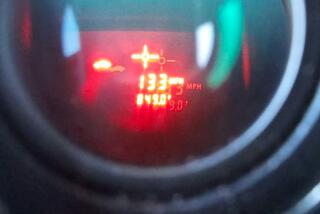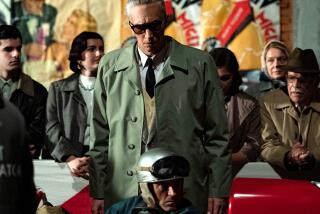With a Porsche Carrera 4, the Fun Is in Getting There
- Share via
We were a Teutonic party of two enjoying a friendly joust where U.S. 101 swoops and loops toward Santa Barbara.
Although smartly driven, the Volkswagen Jetta GLI 16-valve was no match for the Porsche Carrera 4. The Porsche is a full three seconds quicker to 60 m.p.h. Flat out in fifth gear, a GLI is still slower than a Carrera fooling around in fourth--and the Porsche has one more gear and another 30-m.p.h. up its intimidating sleeve.
So the Volkswagen sprinted and I tucked the Porsche in tight as we whistled in tandem past Mussel Shoals. He moved over and invited the Porsche alongside. Side-by-side, I downshifted to show the flashy, top-end acceleration produced by 3.6 liters and 247 horsepower.
Goleta, right lane. I signaled to exit. The gamboling Jetta came up slowly and its driver pressed a yellow legal pad against the passenger window. He had written: “I can only dream.”
Salivating for a Porsche, of course, has been an American pastime since Ferdinand Porsche produced his first bathtub speedster in 1948. Introduction of the Porsche 911 in 1964 only moved adult fantasies further away from Paul Newman’s cool and Stan Musial’s swing.
With the Carrera 4 cabriolet, Porsche now is meddling with the minds and souls of everybody over the age of 15--including grade-schoolers who have just realized there is more to cars than those by Fisher-Price with red wooden wheels.
The Carrera 4 was unveiled in Europe last year, and was promptly credited with being the true force behind the immigration of 4.5 million East Germans to West Germany.
The cabriolet is now on sale in Southern California. It may well be one of the finest sports cars this appreciative, climatically superior area has seen.
It does not have the brute shove and thunder of, say, the Chevrolet Corvette ZR1 or the Lamborghini Countach. But they are a hard day’s work. The Carrera 4 is gentler, more street comfortable yet shows ZR1 performance at speeds where the cautious majority dwell.
The Ferrari 328GTS is shapelier, snootier, has the more expansive image and a pedigree longer than Lassie’s. But it costs more than the Carrera 4, requires a six-figure income to maintain and should not be entrusted to parking valets nicknamed Highball. You also have to be a very good driver to really enjoy a Ferrari.
As its numeral suggests, the Carrera 4 is four-wheel drive.
It also is enhanced by a thinking transmission, a system of sensors that automatically apportion torque, i.e. power, to the wheels with the best grip. More important, it reduces torque to wheels that may be losing their traction on gravel or greasy freeways. And it can make these adjustments to road conditions as often as 10 times a second. This microsecond process of maintaining optimum traction by even distribution of power, also augments the balance, ergo stability of the car.
And that effectively cures the costly and sometimes injurious habit of Porsches: the tradition of coming unstuck during moments of mishandling and attacking walls and other obstructions with their rear ends.
In so many other areas, this is not your vater’s 911.
In truth, the car shares only 15% of the pieces and portions of earlier 911s and has evolved as the most sophisticated 911 to enter freeway service.
The bonus is technology borrowed from the unassailable Porsche 959, the company’s 200-m.p.h., $200,000 supercar--a limited-edition vehicle that the federal government has decreed cannot be imported into the United States.
The evergreen, horizontally opposed, six-cylinder engine (a configuration more associated with airplane engines, hence Porsche’s reputation for low flying) has been enlarged yet again. Displacement is up and horsepower is heavier by 15%. That’s good for a top speed of 160 m.p.h.(faster than most light airplanes) and acceleration times quicker than a Ferrari Testarossa.
The Carrera 4 comes with antilock brakes and power-assisted steering and is the first 911 to be equipped with either. The platform has been stiffened and the suspension redesigned. Sixteen-inch wheels with 12-inch disc brakes are more than adequate for harnessing the lusty thrust and safe halting of high-speed travel.
This technology melds in a car of immense security, quality and unity--yet also a vehicle guaranteed to release its operator from the seriousness and responsibility implied by such qualities.
Make no mistake. The Carerra 4 is a bred-in-the-unibody sports car. The suspension is stiff enough that running over a toothpick feels like a railroad tie. Long trips might even be considered a solo proposition because the only time a couple should be this close is on a motorcycle, in a kayak, or on their honeymoon.
But then a sports car isn’t for commuting comforts or grocery store conveniences. It is built to ride hard and tight because tactile readouts from the glutei are the only way to monitor the limits of machine, road and driver.
A Porsche does not exist for our transportation but is there to provide joy and pleasure. For as there is absolutely no purpose beyond personal exhilaration in galloping a horse, there is no point to driving a Porsche unless you enjoy frolics until your hands shake.
And the Carrera 4 does allow one to dare.
Because although terribly fast, rigidly stable, nimble and most definitely a race car in suburban clothing, this Porsche is no more difficult to drive than a Mazda minitruck.
Of course it is dreadfully expensive, and, at $80,000, the cabriolet is some eight grand more dreadfully expensive than the coupe. But if you just want to tell the time, buy a Timex. If you want to be reminded that quality is timeless, that measurement is meaningless without benchmarks, then you go into hock for a Rolex.
In styling the Carerra 4, Porsche has produced what a spokesman described as the “extensively revised, yet totally familiar.” That means any resemblance between this and other 911s is purely intentional. Even going cabriolet (although topless seems to overemphasize the Cyclopean optics of its mid-level brake light) has not neutered the classical.
Some might have wanted a more radical styling departure, maybe even along the wonderfully rounded and modern lines of the 959. Yet enough buyers will be satisfied by the mildly updated body, the nosepiece-skirt with lines undisturbed by fog lights and turn signals and its richly rounded rear counterpart.
All of which seems to have softened and gently improved the form without bowdlerizing the 911’s traditional profile.
The car’s interior is equally familiar, although the high-visibility analogue dials are now equipped with clusters of warning lights. Switch on and it’s a pinball machine.
Turn signals, lights (now controlled by turning a knob instead of pulling it out), wipers and climate controls are located by memory and logic--although a couple of heater knobs at the left of the layout are blocked by the steering wheel and that calls for some looking and fumbling.
Raising and lowering the top is a one-button breeze. Even latching and unlatching is automatic and a convenience snitched from the new Mercedes SL series. Only the tonneau cover needs to be snapped in place manually.
The interior on the test car was marshmallow-white leather and fabrics suggesting Caesars Palace kitsch more than Porsche elegance. Mushroom or gray would have gone better with the Carrera’s rich blue exterior. Actually, the color was listed as Baltic Blue and how’s that for a high example of glasnost?
Lateral hold of the seating (controlled by a mix of mechanical and electrical) was not up to the performance of the car. In a vehicle of such brisk pace and maneuvering, super seats with lumbar supports and thigh adjustments should be a given.
Not that much of this matters once the car is in motion and its throaty six is making a titanium growl that always can be recognized at distance. Because it belongs only to a Porsche.
So does the handling. Power-assisted steering has done nothing to deaden precise and critical information from the set of the wheels. Balance is a new experience because four-wheel power reduces the seesaw effect of acceleration. It also evens weight distribution when the throttle is lifted hard and suspension loads shift forward.
Consequently, a car that once would spin out if you thought hard enough now corners with a most predictable and controllable program of understeer and oversteer.
The Carrera 4 is faster than you will ever want to travel. It drives flat and with enough heaviness to promise nothing will happen suddenly. Always there is the satisfaction of being a partner in thoroughness of purpose combined with the beauty of pure design.
Now all you need is a Rolex.
1990 PORSCHE CARRERA 4 CABRIOLET COST: *Base, $77,800. *As tested, $80,257 (includes gas-guzzler tax, destination charge, metallic paint). ENGINE: *Six-cylinder, horizontally opposed, twin-plug ignition and 3.6 liters developing 247 horsepower. TYPE: *All-wheel drive, two-seat cabriolet sports car. PERFORMANCE: *0-60 m.p.h. (as tested) 5.7 seconds. *Top speed (manufacturer’s track measurement) 162 m.p.h. *Fuel economy (EPA city-highway) 15-22 m.p.g. CURB WEIGHT: *3,200 pounds. THE GOOD: *Deliciously wicked performance. *All-wheel drive balance, almost passive handling. *Absence of convertible wind noise. *Design unity, deliberate quality. THE BAD: *Sub-par seating. *Uncoordinated interior color. *Hidden heater controls. THE UGLY: *Mid-level brake light? Or mushroom deodorant?






